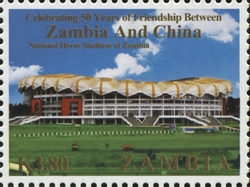Stamp: Celebrating 50 Years of Friendship between Zambia and China (Zambia 2015)
Celebrating 50 Years of Friendship between Zambia and China (Zambia 2015)
02 February (Zambia ) within release Celebrating 50 Years of Friendship between Zambia and China goes into circulation Stamp Celebrating 50 Years of Friendship between Zambia and China face value 3.80 Zambian first kwacha
| Stamp Celebrating 50 Years of Friendship between Zambia and China in catalogues | |
|---|---|
| WADP Numbering System - WNS: | WAD:ZM004.15 |
Stamp is horizontal format.
Also in the issue Celebrating 50 Years of Friendship between Zambia and China:
- Stamp - Celebrating 50 Years of Friendship between Zambia and China face value 2.50;
- Stamp - Celebrating 50 Years of Friendship between Zambia and China face value 3;
- Stamp - Celebrating 50 Years of Friendship between Zambia and China face value 3.50;
- Stamp - Celebrating 50 Years of Friendship between Zambia and China face value 3.80;
- Stamp - Celebrating 50 Years of Friendship between Zambia and China face value 4.05;
- Stamp - Celebrating 50 Years of Friendship between Zambia and China face value 4.95;
- Mini Sheet - Celebrating 50 Years of Friendship between Zambia and China face value ;
Stamp Celebrating 50 Years of Friendship between Zambia and China it reflects the thematic directions:
The modern era or the modern period is considered the current historical period of human history. It was originally applied to the history of Europe and Western history for events that came after the Middle Ages, often from around the year 1500, like the Reformation in Germany giving rise to Protestantism. From the 1990s, it is more common among historians to refer to the period after the Middle Ages and up to the 19th century as the early modern period. The modern period is today more often used for events from the 19th century until today. The time from the end of World War II (1945) can also be described as being part of contemporary history. The common definition of the modern period today is often associated with events like the French Revolution, the Industrial Revolution, and the transition to nationalism towards the liberal international order.
Architecture (Latin architectura, from the Greek ἀρχιτέκτων arkhitekton "architect", from ἀρχι- "chief" and τέκτων "builder") is both the process and the product of planning, designing, and constructing buildings and other physical structures. Architectural works, in the material form of buildings, are often perceived as cultural symbols and as works of art. Historical civilizations are often identified with their surviving architectural achievements.

